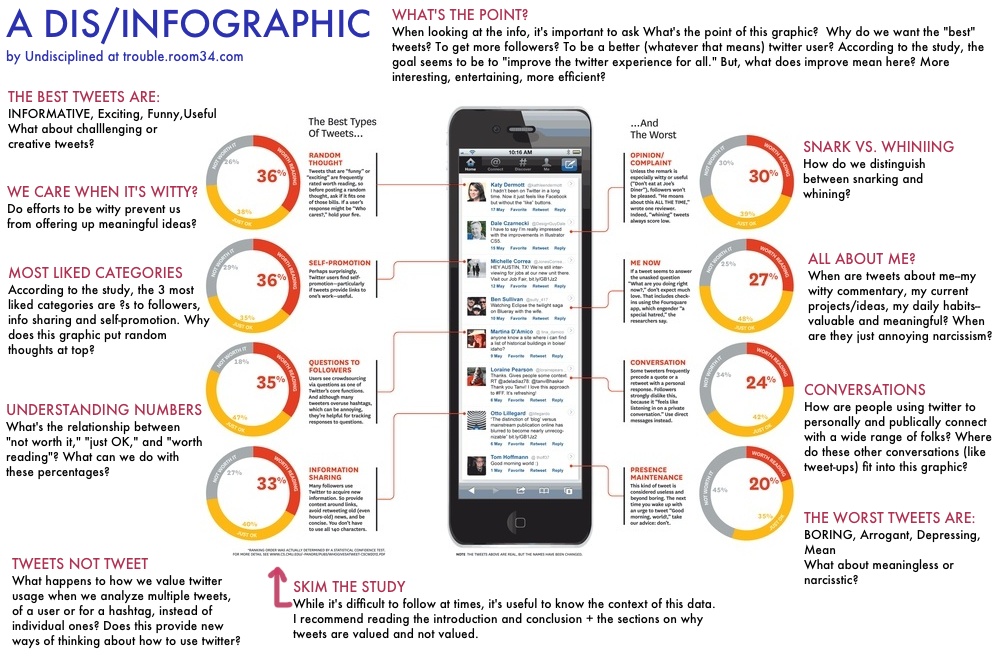Periodically I like to clean out my safari reader and my email and archive some of the more useful links that I’ve marked or emailed to myself. Today, I found some links about tweetbombs and the ethics of attention, The Nation and their new community guidelines policy and the subjectivity of slacktivism. These links are all from the month of April and all concern ethics and social media, two big interests for me in my own engagement with troublemaking.
The Tweetbomb and the Ethics of Attention
A blog post by Ethan Zuckerman.
In this article, Zuckerman reflects on the ethics of using twitter, specifically tweetbombing, to get the attention of key celebrities/personalities. He recounts how World of Warcraft gamer “Athene” and his ipowerproject.com targeted Xeni Jardin by sending her tons of tweets about “starving children in the horn of Africa.” When she tweeted back that the tweets “were not cool,” especially because they clogged up her feed and prevented her from engaging in her ongoing conversations with other twitter users about chemotherapy and living with breast cancer, the tweetbombs became increasingly abusive. Zuckerman wonders about the ethics of attention and how twitter users and Twitter (as a company and administrator of the platform) should/can address the issue of tweetbombing and the problems with demanding, not just requesting, the attention of others on twitter. This article is useful for learning more about the history of tweetbombing. And, as an added bonus, Zuckerman repeatedly describes the unethical actions of Athene and the twitterbombers he enlisted as those of “assholes.” Nice. Might be helpful with my own project of the troublemaking ethical imperative: Don’t be an asshole.
Community Guidelines: The Nation
A page on The Nation’s website.
I follow The Nation on twitter and couldn’t resist checking out the tweet they posted yesterday on their new community guidelines. While I haven’t done that much research on community guidelines/comment policies around the interwebs, I have been interested for some time in how various organizations/sites grapple with ethical issues concerning the management of online communities and conversations. (For example, yesterday, I mentioned Pinterest’s “be nice” rule in my blog post.)
Some interesting points that I found on their description:
1. They call people out for the classic, “I’m not racist, but…”
We do not welcome homophobia, sexism, racism, classism, anti-Semitism or other intolerance. Keep in mind that this does not always take the form of racial slurs. If you find yourself typing “I’m not racist but…” or “I’m not sexist but…” you should probably think twice.
2. They caution agains derailing a conversation. I like this idea, and think it’s important to keep comments focused, but this seems like it could be hard to manage…and very time consuming:
De-railing. Posts unrelated to the article at hand will be deleted. We define this loosely so as to encourage the free flow of conversation. However, if it’s obvious you didn’t read the post, and don’t care to, your comment will be deleted.
3. They encourage users to help out with the labor of managing the community by providing various ways for readers to guide/develop the community, like flagging inappropriate/abusive comments and liking particularly good comments. I suppose this partly answers my question in #2.
Thinking more about these community guidelines has made me curious: Does The Nation hire someone full time to manage this community? How is the difficult labor of this job compensated? Thanks to a quick search on google, I have one answer to these questions. Check out this job posting for a comment moderator at the Huffington Post:
This is an entry level position and we will train you. If you can read quickly, make quick, impartial, decisions and want a foot in the door in community management or online media then this is a perfect job.
Preferred skills:
– Focused speed reading – our moderators read the equivalent of Moby Dick 18 times a month.
– Experience moderating blog or forum based communities a plus.
– Availability during weekends and evenings a big plus.
The Subjectivity of Slacktivism
An online article by Sarah Kendzior at ALJAZEERA
In this online article, Kendzior briefly summarizes the critiques leveled at slacktivists, especially those involved in the Kony2012 campaign, and then argues that what is missing in these discussion is the voice/voices of the slacktivist:
What the conversation on slacktivism is missing is the voice of the slacktivist. Their self-defence is often dismissed as irrelevant – who would confess to lazily clicking “like”? But slacktivism is not a “useless and harmful” way of describing online behaviour, as Tufekci has argued. Slacktivism is a real thing – it is one of the varied and often contradictory ways we engage with political material online. The same people who are slacktivists toward one cause can also be staunch and sincere advocates of others. The same people who engage in low-stakes, pointless actions – changing their profile picture to a cartoon to protect child abuse, turning their Twitter green to save Iran – could have a passionate commitment to the cause in question, but no knowledge of how else to participate.
She continues by comparing the Kony2012 and Trayvon Martin hoodie campaigns and then wonders, “whether it is the choice of cause, and not the method of media engagement, that gives slacktivism its ugly connotation?” I like her conclusion. She argues that we can’t just dismiss slacktivism without first closely looking at our motivations for slacktively (did I just make up that word?) supporting a cause, motivations like curiosity or sympathy and empathy.

